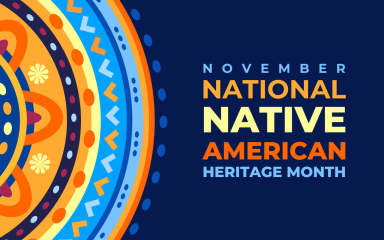Celebrating Native American Heritage Month: A tribute to rich cultures and histories

November marks the celebration of Native American Heritage Month—a time to honor the rich tapestry of cultures, traditions, languages and stories of Native American, Alaska Native, Native Hawaiian and affiliated Island communities. We do this to ensure their rich histories and contributions continue to thrive and be celebrated with each passing generation. As we embark on this journey of understanding and appreciation, let’s talk about how this month came to be, why we celebrate it and how everyone, regardless of heritage, can participate in the festivities.
Why we celebrate
Celebrating Native American Heritage Month isn’t just about honoring the past and the history of Indigenous peoples; it’s about acknowledging their enduring presence, strength and resilience. Celebrating this month reminds us that Native American cultures are alive and thriving, despite centuries of oppression, displacement and erasure.
It's also an opportunity to educate the broader public about the diverse cultures, languages and traditions of the tribes within the United States. This month encourages reflection on historical injustices, while celebrating the survival and contributions of Native Americans.
Fascinating facts and insights
Native Americans aren’t a monolithic group; there are 574 federally recognized tribes in the United States today. Each of these tribes has its own distinct traditions and cultural practices.
It’s estimated that there were over 300 distinct languages spoken by Indigenous people in North America. Efforts continue today to revive and preserve these languages.
Many staple crops that are common today, like corn, beans and squash, were cultivated by Native Americans. These are often referred to as the “Three Sisters” and were central to Indigenous agricultural practices.
The Iroquois Confederacy’s constitution, known as the “Great Law of Peace,” influenced the US Constitution in some ways, such as separating responsibilities to balance power.
How to honor and celebrate Native American heritage
For those who don’t share Native American heritage, there are several meaningful and respectful ways to observe Native American Heritage Month.
Educate yourself. Take the time to learn about the diverse Indigenous cultures, languages and histories. Read books written by Native authors, watch documentaries, or attend virtual or in-person lectures.
Support Native-owned businesses and artists. One of the best ways to honor Indigenous peoples is by supporting Native-owned businesses, artists and craftsmen. Purchasing authentic products helps sustain Native economies and preserve cultural traditions.
Visit museums and cultural centers. Visit museums with exhibits that focus on Native American history and art. These places can help deepen your understanding and appreciation of Native cultures.
Acknowledge the land you live on. Learn about the Indigenous peoples who lived on the land before it became your community. It’s a simple yet meaningful way to show respect.
Advocate for Native American rights. Awareness is key to making progress on issues that still impact Native American communities today, such as healthcare access, sovereignty and protection of sacred lands.
Moving forward together
Native American Heritage Month is a time for reflection, respect and celebration. By engaging with Native cultures and histories, we can help foster greater understanding and appreciation for the significant—and ongoing—contributions of Indigenous peoples. Through meaningful actions and education, we can all play a role in honoring Native American heritage—not just in November but all year long.



